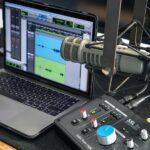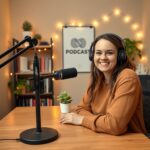Starting a podcast involves many crucial decisions, with choosing the best microphone for podcasting being one of the most important. A high-quality microphone can elevate your sound, while a poor choice may frustrate your audience. Audio quality is crucial, so investing in the best microphone for podcasting will impact how your podcast is perceived. So, what features should you prioritize to ensure you’re selecting the best microphone for podcasting? Let’s dive into the essentials.

1. Sound Quality
First and foremost, sound quality is key. The best microphone for podcasting must offer crystal-clear audio with minimal distortion. Condenser microphones capture detailed sound, while dynamic microphones excel in noisy environments by focusing on the speaker’s voice. A cardioid pickup pattern isolates sound from the front and reduces room noise from the sides and rear.
In addition, some microphones offer multi-pattern options, allowing you to switch between cardioid, omnidirectional, and bidirectional settings. This flexibility is useful for hosting interviews, recording multiple speakers, or capturing ambient sounds. Choosing a microphone that adapts to different recording scenarios ensures you’re future-proofing your podcast setup.
Moreover, pay attention to the frequency response of a microphone. The ideal range for voice recording typically falls between 80 Hz and 15 kHz. A microphone that captures all frequencies enhances voice warmth and clarity, giving recordings a polished and professional sound.
2. Connectivity
When selecting the best microphone for podcasting, consider connectivity. USB mics are perfect for beginners with their plug-and-play simplicity, making them ideal for quick setups. You can connect them directly to your computer without extra equipment, making them ideal for budget-conscious podcasters.
However, consider an XLR microphone with an audio interface for more control and higher audio quality, especially if you plan to grow your podcasting career. XLR setups are more complex but offer superior sound and flexibility. They allow for easier upgrades and better integration with mixers, preamps, and audio processors, which can be crucial if you want to expand your podcast into a multi-person show or produce highly edited content.
Additionally, some podcasters opt for hybrid microphones that support both USB and XLR outputs. This gives you the option to start simple and later upgrade your setup without replacing your microphone.
3. Durability and Build
A well-built microphone ensures long-term reliability. Choose one with a sturdy, metal construction for durability. When you invest in the best microphone for podcasting, you want a device that withstands frequent use, transport, and the occasional knock or fall without compromising performance.
Many microphones feature built-in pop filters, shock mounts, and adjustable gain controls, which help reduce distortion and improve your recording experience. A rugged design is particularly important if you plan to travel or record in different locations. Portable podcasting demands equipment that can handle a bit of rough treatment while still delivering exceptional audio.
Also, check if the microphone has replaceable parts. For example, detachable cables and removable pop filters can prolong the life of your equipment and save you money in the long run.
4. Additional Features
Look for microphones with features that can enhance your recording setup. A pop filter minimizes plosive sounds, while a shock mount prevents low-frequency vibrations and handling noise. These accessories might seem minor, but they significantly improve the final audio output.
Some mics also offer customizable sound options, such as low-frequency cuts or clarity boosts, making it easier to tailor the sound to your environment. For instance, if you record in a room with a lot of low-end rumble (like air conditioning noise), a low-cut filter can eliminate those unwanted frequencies.
Other features that might come in handy include mute buttons, headphone output for real-time monitoring, adjustable sensitivity levels, and LED indicators for sound clipping. While not essential, these additions can make your workflow smoother and help you produce better results with less hassle.
Having the best microphone for podcasting equipped with thoughtful features means less time spent troubleshooting and more time creating valuable content for your audience.
Characteristics of a Good Podcasting Mic
- Cardioid Pickup Pattern: This pattern minimizes background noise by being less sensitive to sounds from the sides and rear, ensuring clear voice capture.
- Pop Filter: This reduces plosive sounds and improves audio quality. It can be an internal foam layer or an external filter.
- Shock Mount: Filters low-frequency vibrations and handling noise, essential for clearer audio.
- Sound Customization: Adjustments like cutting bass or boosting clarity can help enhance voice quality and minimize room noise.
- Ease of Use: Especially for solo podcasters, a simple setup saves time and reduces technical frustrations. The best microphone for podcasting should be user-friendly and intuitive, even for beginners.
- Affordability: While premium models offer amazing quality, there are budget-friendly options that still deliver excellent performance. Assess your needs and find the best microphone for podcasting that fits both your standards and your wallet.
Conclusion
In conclusion, the best microphone for podcasting balances sound quality, connectivity, durability, and features like pop filters and shock mounts. Selecting the right microphone requires understanding the specific needs of your recording environment and future plans for your podcast.
By understanding these key elements, you can confidently choose a microphone that delivers professional-quality sound, ensuring your podcast stands out. Whether starting or upgrading, investing in the best microphone for podcasting is key to building a loyal audience.
Remember, in podcasting, your voice is your brand, so choose the best microphone for podcasting to ensure clear, beautiful sound.


